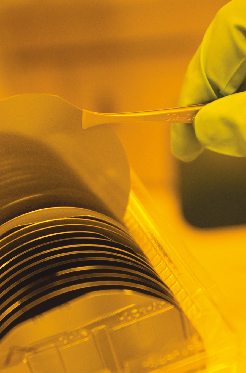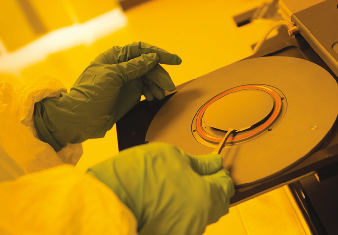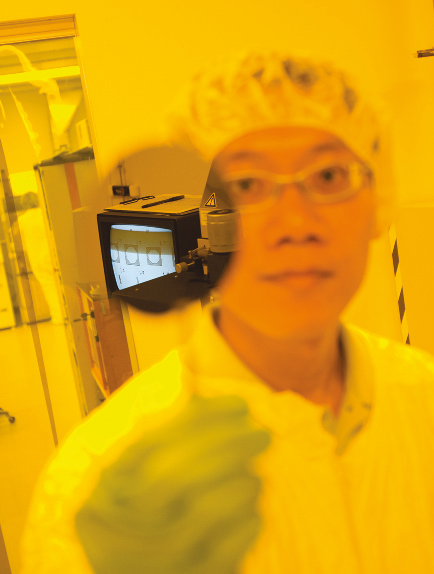THE UNCANDESCENT LAMP, ALSO KNOWN AS THE EVERYDAY LIGHTBULB, has done yeoman's work in lighting the world's buildings, flashlights and billboards since its invention in the late 19th century.
It has also come to represent one of the world's most notorious guzzlers of electric power.
When it is switched on, says the U.S. Department of Energy (DOE), the ordinary lightbulb becomes extraordinarily wasteful, dissipating 95 percent or more of its energy as invisible infrared light or heat.
This is no trivial loss of power. about one-third of the energy generated in the U.S., for example, is used to provide electricity, and about 22 percent of this electrical power is used to light buildings.
Not surprisingly, consumers are beginning to switch to fluorescent lamps, which are more energy-efficient and longer-lasting than lightbulbs. But fluorescent lighting uses mercury vapor, which poses environmental and health concerns.
A safer alternative to the lightbulb’s meager return on investment, says nelson Tansu, is solid-state lighting, which relies on light-emitting diodes. Leds are already used in cell phones, car dashboards and the backlighting in the liquid crystal displays in laptops and TVs. They are also found in a growing number of traffic signals and city and highway billboards.
White Led light, says DOE’s Sandia National Laboratory in its Web site, now achieves twice the luminous efficacy of a lightbulb and one-third that of a fluorescent lamp. in the future, however, LEDs could outpace incandescent lighting by 10 times while doubling the efficacy of fluorescent lighting.
This promise will not become reality, however, until engineers overcome natural limits to the “radiative efficiency” of LED light that occur at the nanoscale.
Tansu and Volkmar Dierolf, an associate professor of physics, have received a three-year grant from DOE to study methods of improving the efficiency of white LEDs. Both are faculty researchers in Lehigh’s Center for Optical Technologies (COT).
“We hope that by greatly improving the efficiency of the electrical power currently used for lighting,” says Tansu, “solid-state lighting can significantly reduce the worldwide demand for energy, while providing reliable and environmentally friendly solutions.”
The DOE award, matched in part by funding from the State of Pennsylvania, is being provided through DOE’s Solid-State Lighting Core Technology Research (CTR) program. The agency’s goal is to develop, by 2025, inexpensive and long-lasting solidstate lighting technologies that achieve 50 percent efficiency while reproducing the spectrum of sunlight.
The competitive CTR grants were awarded last year to five U.S. research groups. Two groups – Lehigh’s and one from the Georgia Institute of Technology – are based at universities. The rest are led by industrial consortiums.
A green light to the future
The light generated by an LED is emitted from a semiconducting material – usually indium gallium nitride (InGaN) or gallium phosphide (GaP) – within the LED.
An InGaN semiconductor emits light in the blue and green portions of the spectrum, and a GaP semiconductor emits light in the red spectrum. a white LED must mix these colors in the correct proportion to produce white light. It can achieve this through wavelength conversion or through color mixing, in which multiple LEDs, each one the size of a human hair, are combined in a single lamp to produce white light.
The catch, says Tansu, is the relative inefficiency of the green light produced by an LED. When combined with red and blue LED light to produce white light, this shortcoming limits the overall “radiative efficiency” of the white LED light.
The inefficiency of green LED light, says Tansu, stems from a phenomenon called the charge-separation effect, which occurs when electron and electron hole carriers are spatially separated inside the nanoscale quantum-well active region of LED devices.
In nitride LEDs, says Tansu, a large internal polarization field exists in the InGaN semiconductor quantum well that is required to generate green light. But the polarization field creates an electrical field inside the active region of the semiconductor, and the electrical field in turn promotes the separation of electron and electron hole carriers in the active region.
“This leads to a reduction in the radiative transition probability rate for electron and electron hole carriers in the active region that is responsible for generating light radiation,” says Tansu.
To achieve a higher efficiency of green LED light and boost the radiative efficiency of the overall LED, Tansu is attempting to engineer a 2- or 3-nanometer structure which allows the electron and electron hole carriers to align more precisely.
“We need to engineer the spatial position of both the electron and the hole carriers to the center of the nanostructure-active region to increase the chance that they will overlap,” says Tansu. “To do this, we use quantum mechanics to design the nanostructures for engineering the electron and hole wave functions, which will result in a significantly enhanced radiative efficiency.”
Tansu reported the results of his work in 2007 in the Proceedings of the IEEE/OSA Conference on Lasers and Electro-Optics (CLEO) and in Applied Physics Letters (APL). The APL article was coauthored with Ronald A. Arif and Yik-Khoon Ee, Ph.D. candidates and members of Tansu’s group. Laser Focus World has also reported on Tansu’s use of staggered InGaN quantum wells to enhance the radiative efficiency of nitride LEDs.
Tansu and his group, including Hongping Zhao, a Ph.D. candidate, are pursuing other approaches based on type-II nitride-based quantum wells and ingan quantum dots. The results of these studies have been published in APL and the Journal of Crystal Growth.
In a related effort to improve the efficiency of LEDs, Tansu and his group are experimenting with arrays of microlenses to extract, with greater efficiency, the light that is generated in quantum-well nanostructures but then trapped inside the structures in part because of the large refractive-index difference between gallium nitride and air.
The group has published the results of this research in APL in an article that was coauthored with James Gilchrist, assistant professor of chemical engineering at lehigh, and Pisist Kumnorkaew, a graduate student in chemical engineering.
The group’s work with microarrays was featured in 2008 in Laser Focus World, which said the arrays promised to improve light-extraction efficiency of LEDs while overcoming three challenges to previous extraction techniques – cost, scalability and process control.
Tansu is also collaborating with professors Rick Vinci and Helen Chan of materials science and engineering on research aimed at reducing defect density by decreasing the non-radiative recombination process in gallium-nitride semiconductors, which in turn will improve the radiative efficiency of the LED. This project is supported by NSF. Tansu’s group has also received funding from NSF’s Electronics Photonics Devices Technology research program. Tansu has filed patent applications on the microlens array and staggered quantum wells, as well as the type-II nitride-based quantum wells.
Tansu, Dierolf, Arif, Ee and Zhao are affiliated with the COT, while Gilchrist, Chan, Vinci and Kumnorkaew are affiliated with the university’s Center for Advanced Materials and Nanotechnology.



